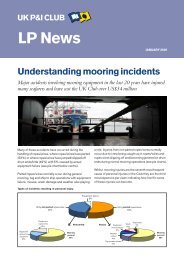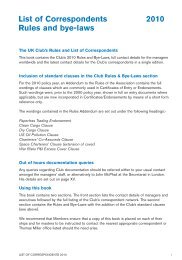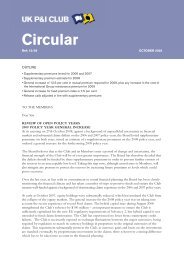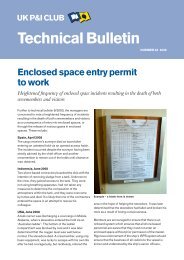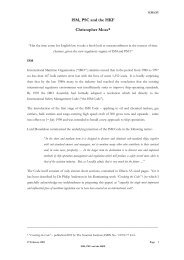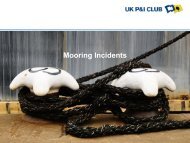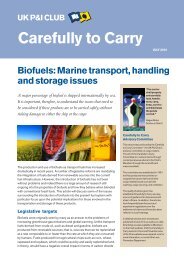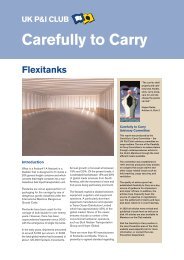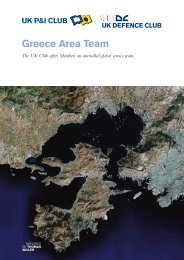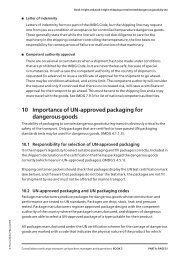Bulk Matters - UK P&I
Bulk Matters - UK P&I
Bulk Matters - UK P&I
Create successful ePaper yourself
Turn your PDF publications into a flip-book with our unique Google optimized e-Paper software.
ventilation cannot significantly affect a heating process<br />
which is occurring more than about a metre below the<br />
surface. What can occur when the surface of a heating<br />
cargo is continuously cooled by ventilation, is that the<br />
vapour pressure differential between the interior of the<br />
cargo and the periphery is maintained and consequently<br />
the phenomenon of moisture migration is encouraged.<br />
Stowage regulations<br />
The irrelevance of surface ventilation to the carriage of<br />
grain is apparent from the stowage regulations in force<br />
in all major grain exporting countries, which insist that<br />
the vessel be stowed so that shifting of the cargo is<br />
impossible. Under these regulations, a ship’s grain<br />
carrying compartments are classified as either partly<br />
filled or full. Grain in partly filled compartments must be<br />
levelled and topped off with bagged grain or other<br />
suitable cargo, tightly stowed and extending to a height<br />
of 1-2m above the bulk. The bagged grain or other<br />
suitable cargo must itself be supported by a platform<br />
made either of close boarded wood, or strong<br />
separation cloths laid over the whole surface of the bulk<br />
cargo.<br />
These regulations provide that in compartments totally<br />
filled with grain, the grain shall be trimmed so as to fill all<br />
the spaces between the beams, in the wings and ends.<br />
Further, to ensure that the compartment is maintained<br />
fully filled during the voyage, the compartment must be<br />
equipped with a feeder, from which grain can flow into<br />
the compartment if the cargo settles during the voyage.<br />
Alternatively the grain in the area of the hatch may be<br />
trimmed hard up to the deckhead beyond the hatchway<br />
to form a saucer. This saucer and the hatchway above is<br />
then filled with bagged grain or other suitable cargo<br />
extending to a height of at least two metres in the centre<br />
of the saucer. The bagged grain or other suitable cargo<br />
must itself be stowed tightly against the deckhead, and<br />
the longitudinal bulkheads, the hatch beams and hatch<br />
coamings.<br />
The express purpose of the regulations, is to reduce to a<br />
minimum – and if possible to eliminate – the head space<br />
between the surface of the cargo and the overlying<br />
deck. With cargo stowed correctly in this way there is<br />
no possibility of effective surface ventilation.<br />
Other cargoes where moisture<br />
migration is substantially more<br />
rapid<br />
We took grain stowed in bulk as a first example because<br />
this probably represents a cargo in which moisture<br />
migration is the slowest compared with other cargoes<br />
which may be carried both in bulk and in bags.<br />
The rate of moisture migration and the amount of<br />
moisture moving in other cargoes may be higher<br />
because, on the one hand, of differences in voyage and<br />
loading temperature, and, on the other, of the physical<br />
nature of the cargo stowed.<br />
A typical cargo in which rapid moisture movement can<br />
occur is bagged rice. This cargo is usually loaded at a<br />
high temperature and at a moisture content just below<br />
the critical level which is about 14%. If the cargo is<br />
stowed in a block, stow temperature changes in the<br />
external atmosphere and sea water may set up serious<br />
temperature gradients between the centre and<br />
peripheral regions of the stow, with the result that<br />
massive moisture movement occurs leading to the<br />
formation of both cargo sweat and ship’s sweat. This in<br />
turn results in part of the cargo becoming excessively<br />
wetted. Microbiological deterioration occurs in the<br />
wetted cargo.<br />
In order to prevent or minimise this problem, bagged<br />
rice is normally stowed so that linked vertical and<br />
horizontal ventilation shafts are incorporated in the stow<br />
to facilitate moisture movement from the bulk to the<br />
external atmospheres.<br />
Even with this form of stowage, when a rapid fall in<br />
external temperature occurs, as might be experienced<br />
with a vessel sailing to Northern Europe in the winter,<br />
serious sweat formation can result. This is well known<br />
to surveyors working in Northern European ports<br />
A similar phenomenon also occurs with bagged cocoa<br />
shipped from West Africa to Northern Europe. Here,<br />
the cargo is artificially dried so that ventilation in the<br />
early stages of a voyage, i.e. before about the latitude of<br />
Dakar, can result in the cargo picking up moisture from<br />
the atmosphere and is not normally recommended.<br />
After this, ventilation may be used to minimise sweat<br />
formation; but it must be borne in mind that cooling the<br />
surface of the cargo encourages moisture migration by<br />
increasing the temperature gradient between the bulk<br />
and the surface of the cargo, and may also result in the<br />
formation of cargo sweat. Thus, shock cooling of the<br />
surfaces of the cargo should be avoided and ventilation<br />
during the hours of darkness or during cold weather is<br />
probably best avoided.<br />
It can be shown by calculation that, in any event, when<br />
cold conditions are encountered, the rate of emission of<br />
moisture from a normal cargo of cocoa can be<br />
substantially higher than the rate at which such<br />
moisture can be removed by a normal ventilating<br />
process, even assuming the ventilating atmosphere<br />
becomes saturated as it passes over the cargo. Thus,<br />
19




